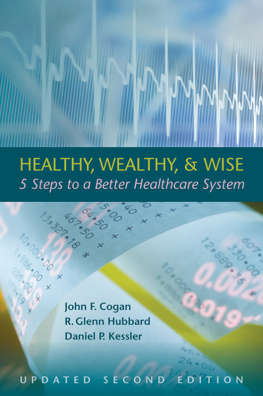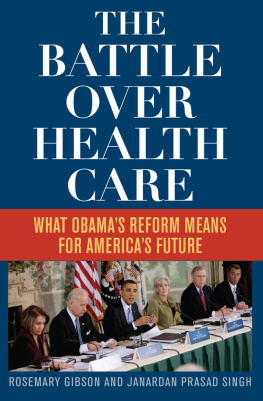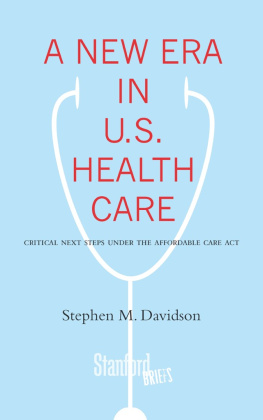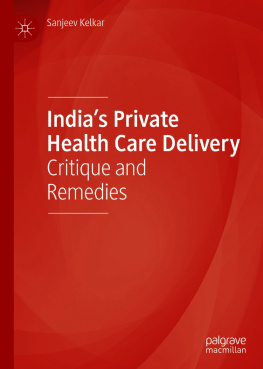Mother of Invention
Mother of Invention
HOW THE GOVERNMENT CREATED FREE-MARKET HEALTH CARE
Robert I. Field


Oxford University Press is a department of the University of Oxford.
It furthers the Universitys objective of excellence in research, scholarship, and education by publishing worldwide.
Oxford New York
Auckland Cape Town Dar es Salaam Hong Kong Karachi Kuala Lumpur Madrid Melbourne Mexico City Nairobi New Delhi Shanghai Taipei Toronto
With offices in
Argentina Austria Brazil Chile Czech Republic France Greece Guatemala Hungary Italy Japan Poland Portugal Singapore South Korea Switzerland Thailand Turkey Ukraine Vietnam
Oxford is a registered trademark of Oxford University Press in the UK and certain other countries.
Published in the United States of America by
Oxford University Press
198 Madison Avenue, New York, NY 10016
Oxford University Press 2014
All rights reserved. No part of this publication may be reproduced, stored in a retrieval system, or transmitted, in any form or by any means, without the prior permission in writing of Oxford University Press, or as expressly permitted by law, by license, or under terms agreed with the appropriate reproduction rights organization. Inquiries concerning reproduction outside the scope of the above should be sent to the Rights Department, Oxford University Press, at the address above.
You must not circulate this work in any other form and you must impose this same condition on any acquirer.
Library of Congress Cataloging-in-Publication Data
Field, Robert I., author.
Mother of invention: how the government created free-market health care / Robert I. Field.
p. ; cm.
Includes bibliographical references.
ISBN 9780199746750 (alk. paper)
I. Title. [DNLM: 1. Health Care SectorUnited States. 2. GovernmentUnited
States. 3. Health Care ReformUnited States. 4. Public-Private Sector PartnershipsUnited
States. W 74 AA1]
RA393
362.1dc23
2013029712
9 8 7 6 5 4 3 2 1
Printed in the United States of America
on acid-free paper
To Mary, David and William
TABLE OF CONTENTS
Keep the government out of my health care. That and similar refrains have permeated health policy debates in the United States for more than a century. Opponents cried socialized medicine when reformers first tried to create government-financed health insurance plans in early part of the twentieth century. They raised the alarm again when President Harry Truman proposed universal coverage in the 1940s, when President Lyndon Johnson proposed Medicare in the 1960s, and when President Bill Clinton put forth his comprehensive reform plan in the 1990s. It is by now a familiar call, and it has often achieved notable success in defeating or forestalling reforms.
The rallying cry was proclaimed with special stridency in recent debates leading up to passage of the Affordable Care Act (ACA), the massive health reform law enacted in 2010. Opponents charged that the law amounted to a government takeover of the health care system. They argued that American health care is doing just fine and may even be the best in world. Why let the government in? It can only mess things up.
Underlying these concerns is an ongoing debate over the relative merits of the government and the private market in delivering and financing health care. Over the years, researchers in academia and think tanks have conducted countless studies and analyses to compare the efficiency, effectiveness, and compassion of both sectors. Often, they compare Americas market-based system to those of Europe, where governments play a more pervasive role. What would happen, they wonder, if the government ran health care in the United States? How would things be different?
The problem with these debates is that they miss a key point. The speculations about government-run health care, both positive and negative, are largely for naught. There is no need to guess about the possible effects of letting the government take over the American health system because it already has.
Take any component of health care in the United States. Its most visible manifestation is likely to be a collection of private companies, many owned by outside investors, doing business with the public and earning profits in return. But look a bit closer and what appears to be a uniformly private sector is revealed as a mosaic of private and public elements. The governments hand is everywhere.
This book examines four such health system components, arguably the four most important. The first is the pharmaceutical industry, which is comprised almost entirely of private investor-owned companies. They create a stream of new products in response to market pressures in an environment that can be highly competitive. Their enterprise and initiative has made them among the most profitable in the country over the past two decades. Yet the ultimate source of innovation for these engines of profit is a massive federal programthe research funding of the National Institutes of Health (NIH). With a budget of almost $30 billion a year, it creates much of the raw intellectual fuel on which the industry thrives. That fuel takes the form of advances in basic biomedical science that makes virtually all of the industrys new products possible.
The second is the hospital industry. The government owns only a small minority of American hospitals. The majority operates as private corporations, some on a for-profit and some on a nonprofit basis. They represent a significant economic presence in cities and towns across the country and offer an ever-growing array of technologically advanced services. This sophisticated care is extremely expensive, so much so that it is out of the financial reach of most patients. Payment from insurance plans is the only viable source of funds, and the government administers the largest single plan in the form of Medicare. Without it, few hospitals in the United States could survive in their present state.
The third is the medical profession. Americas complement of physicians is dominated by specialists who earn more than their colleagues almost anywhere else in the world. Once again, they have the Medicare program to thank. It not only reimburses practitioners for much of the high-end specialty care they deliver at generous levels but also helps to fund their training.
Finally, there is the private insurance industry. It has grown over the past several decades from a niche player into a major force in the financial sector, with huge national corporations playing dominant roles in many markets. They would not exist but for the guiding hand of federal policy. Government decisions shaped the industry in its formative years in the 1930s and 1940s, and government subsidies support it today to a considerable extent with a substantial tax break for coverage provided through employers. Government programs also account for a sizeable share of the industrys overall business by offering private insurers the opportunity to administer coverage under Medicare and Medicaid and by creating and subsidizing a huge market for individual policies sold through insurance exchanges under the ACA.
None of this is news to those who work in these components of the health care industry. Pharmaceutical researchers readily credit NIH funding as the backbone of the research enterprise that creates new drugs. Hospital executives carefully plan their service offerings and medical staff composition around the intricacies of Medicare reimbursement rules. Physicians in many specialties fill their practices with elderly patients who turn to Medicare to cover their bills. Insurance executives vie to market policies to employers that can then offer coverage to workers as a tax-free benefit.
Next page







